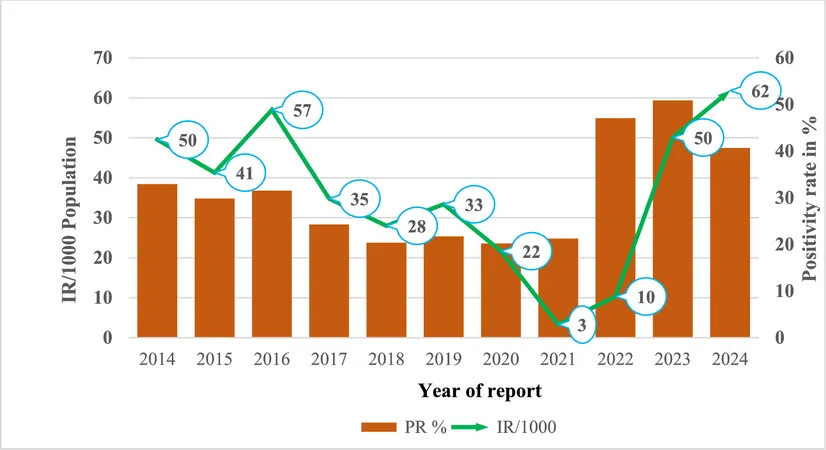
Malaria Crisis in Tigray: A Humanitarian Catastrophe from 2014 to 2024
2025-04-15
Author: Wei Ling
A Stark Increase in Malaria Amid Conflict
Ethiopia has made significant strides in combating malaria; however, the Tigray region faces a dramatic surge in cases driven by a devastating humanitarian crisis. The war that erupted in November 2020 wrecked local health structures, crippling disease surveillance and leading to a dire underreporting of malaria cases. This article explores malaria's trajectory in Tigray between 2014 and 2024 amidst ongoing conflict.
Study Overview: Data and Methodology
In January 2025, a descriptive cross-sectional study assessed malaria data sourced from 2014 to 2024 using public health databases. Researchers analyzed over 7 million suspected cases to uncover essential trends and statistics related to malaria prevalence in the region.
Shocking Statistics: A Closer Look at the Data
Out of 7,195,545 individuals tested, 2,185,318 were confirmed malaria cases, revealing a staggering average incidence rate of 35.37 cases per 1,000 people. The troubling case fatality rate stood at 27 deaths per 100,000. The predominant strain was Plasmodium falciparum, responsible for 65.3% of the infections.
Malaria Peaks Post-War: Why the Surge?
The worst malaria episode unfolded in 2024, with nearly 383,000 cases reported—a drastic rise compared to just 19,110 in 2021. The humanitarian crisis slashed the report completeness rate by 83%, causing significant underreporting. Notably, malaria soared in autumn, primarily impacting individuals aged 15 and older.
The Grim Landscape of Tigray: Geographical and Environmental Factors
Tigray's geography plays a crucial role in malaria transmission. With around 70% of the population living in endemic areas, the region recorded an incidence rate as high as 85 cases per 1,000 in the western zones. Conversely, urban areas like Mekelle reported rates as low as 7 cases per 1,000.
Conclusions: A Call to Action
Despite an initial decline in malaria cases during the crisis, the situation has since deteriorated. The continuity of malaria control measures, especially vector control strategies, is imperative. As we transition into a post-war period, heightened surveillance and community health initiatives will be crucial in combating this persistent public health threat.
Broader Context: Malaria in Africa
Malaria remains a significant concern worldwide, particularly in Africa where over 233 million cases were reported in 2022 alone. Children under five were disproportionately affected, making up a staggering 78.1% of fatalities. Thus, strengthening systems to safeguard vulnerable populations in Tigray and beyond is a pressing necessity.

 Brasil (PT)
Brasil (PT)
 Canada (EN)
Canada (EN)
 Chile (ES)
Chile (ES)
 Česko (CS)
Česko (CS)
 대한민국 (KO)
대한민국 (KO)
 España (ES)
España (ES)
 France (FR)
France (FR)
 Hong Kong (EN)
Hong Kong (EN)
 Italia (IT)
Italia (IT)
 日本 (JA)
日本 (JA)
 Magyarország (HU)
Magyarország (HU)
 Norge (NO)
Norge (NO)
 Polska (PL)
Polska (PL)
 Schweiz (DE)
Schweiz (DE)
 Singapore (EN)
Singapore (EN)
 Sverige (SV)
Sverige (SV)
 Suomi (FI)
Suomi (FI)
 Türkiye (TR)
Türkiye (TR)
 الإمارات العربية المتحدة (AR)
الإمارات العربية المتحدة (AR)